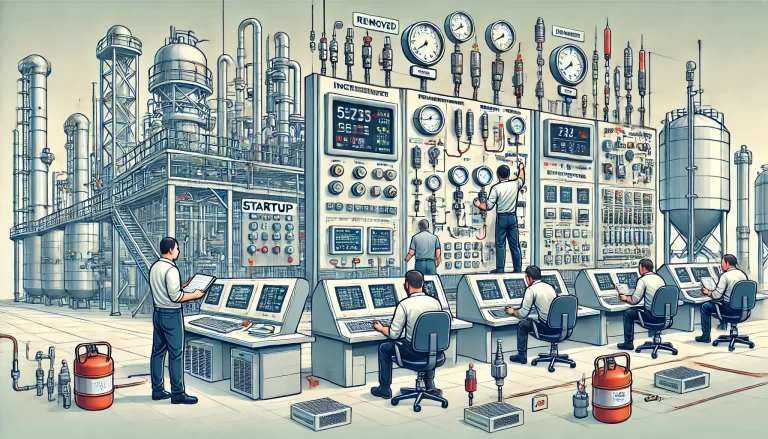In chemical production, startups and shutdowns are routine but critical operations. Short-term shutdowns generally have minimal impact on instruments, with limited adjustments needed by instrumentation personnel. However, this document focuses on large-scale shutdowns and startups, such as those due to major overhauls, extensive stoppages, or events requiring prolonged halts and subsequent restarts of operations. Note that new project commissioning is beyond the scope of this discussion.

1. Shutdown Procedures:
Shutdowns are relatively straightforward, but certain precautions must be taken by instrumentation personnel to ensure safety and operational integrity:
Collaborate Closely with Process Operators: Maintain open communication with process operators to align on shutdown timing and tasks.
Understand the Shutdown Schedule: Be aware of the process shutdown timing and equipment maintenance plans to synchronize instrumentation tasks.
Dismantling Instruments Safely:
Remove instruments and sensors, such as thermocouples, resistance temperature detectors (RTDs), pressure transmitters, float level gauges, and capacitive level meters, from equipment scheduled for maintenance.
Shut off power or gas supply to instruments before dismantling.
Prevent Instrument Damage:
Ensure storage tanks or vessels are emptied before removing differential pressure transmitters. If emptying is challenging, confirm liquid levels are below the flange connections before removal, and install blind flanges promptly afterward.
Protect Wiring and Sensors:
Insulate electrical and signal cable connections with proper materials (e.g., insulating tape) and ensure they are securely placed.
Disconnect power before removing transmitters.
Avoid Blockages and Pressure Hazards:
Gradually release pressure from instruments like pressure transmitters to prevent splashing or injury.
Ensure all residual gas or liquid is vented before instrument removal.
Label Instruments Clearly: Mark instruments with their respective tags and store them in designated locations to avoid mix-ups during reinstallation.
Special Care for Critical Components:
Pay attention to orifice plates during removal to ensure correct orientation and cleanliness.
Prevent pipeline sagging by supporting sections after removing components like flange orifice plates.
Address Interlocked Instruments:
Switch interlocked instruments to manual mode before dismantling.

2. Startup Procedures:
Successful startups hinge on thorough preparation and maintenance. Proper instrument handling during startup minimizes operational disruptions and ensures process continuity. Key precautions include:
Collaborate with Process Operators: Work closely with process personnel to meet startup schedules and maintain safety during installations.
Verify Instrument Positioning:
Reinstall instruments according to their designated positions (tags).
Misalignment during reinstallation can lead to operational failures that are difficult to diagnose.
Restore Power Supply:
Verify instrument wiring and connections before restoring power.
For instruments using 24VDC, ensure voltage levels are within acceptable ranges to prevent malfunctions.
Purge and Clean Air Sources:
Clear rust, dust, and debris from air supply lines and filters before instrument operation.
Ensure clean air supply to pneumatic instruments, positioners, and valves.
Correct Orifice Plate Orientation:
Check for proper orifice plate alignment.
Clean straight pipe sections upstream and downstream of the plate.
Calibrate Level Measurement Devices:
For differential pressure transmitters measuring liquid levels in sealed vessels, refill negative pressure piping with the appropriate liquid to achieve accurate readings.
Inspect Seals and Connectors:
Ensure that pressure transmitters and isolators are filled with appropriate fluids and free from leaks.
Use soap solution to test pneumatic connections for leaks.
Verify Temperature Sensors:
Double-check thermocouple polarity and confirm that RTDs are correctly wired.
Conduct Integrated System Testing:
Perform end-to-end calibration between field devices (e.g., transmitters) and control systems (e.g., Distributed Control Systems – DCS).
Verify the synchronization of regulator outputs and valve positions.
Gradual Ramp-Up for Critical Valves and Flow Meters:
Gradually open bypass valves before activating main valves to avoid sudden pressure surges.
For flow meters, ensure the system is free of debris and progressively open the valves to stabilize flow.
Enable Automatic Control:
Ensure stable manual operation before switching to automatic modes for interlocked loops.
Document and Monitor:
Keep detailed logs of all activities and observations during startup to facilitate troubleshooting and ensure traceability.

By adhering to these guidelines, instrumentation personnel can enhance the safety, reliability, and efficiency of plant startups and shutdowns. Each step emphasizes precision, collaboration, and proactive measures to mitigate risks and maintain operational integrity.
